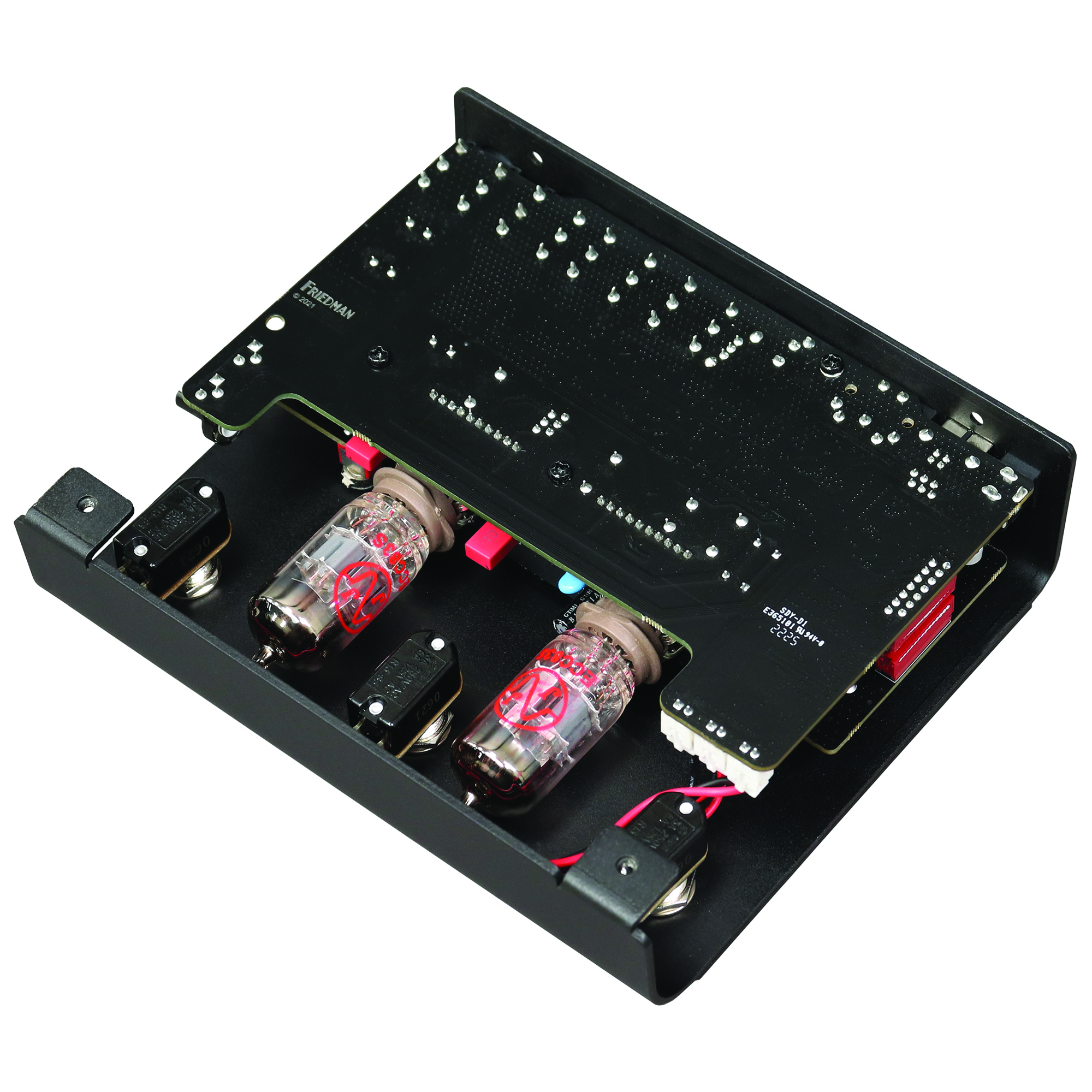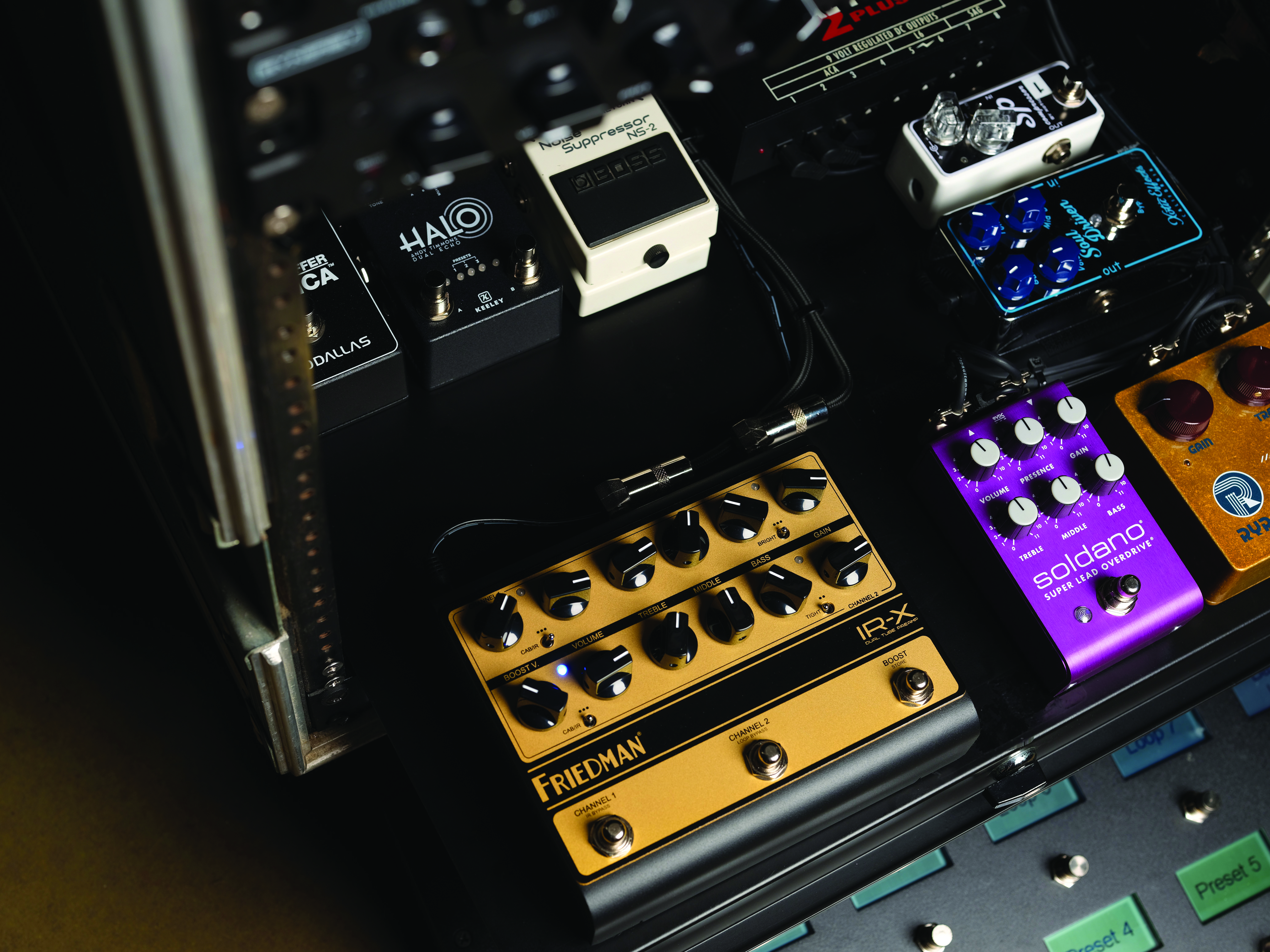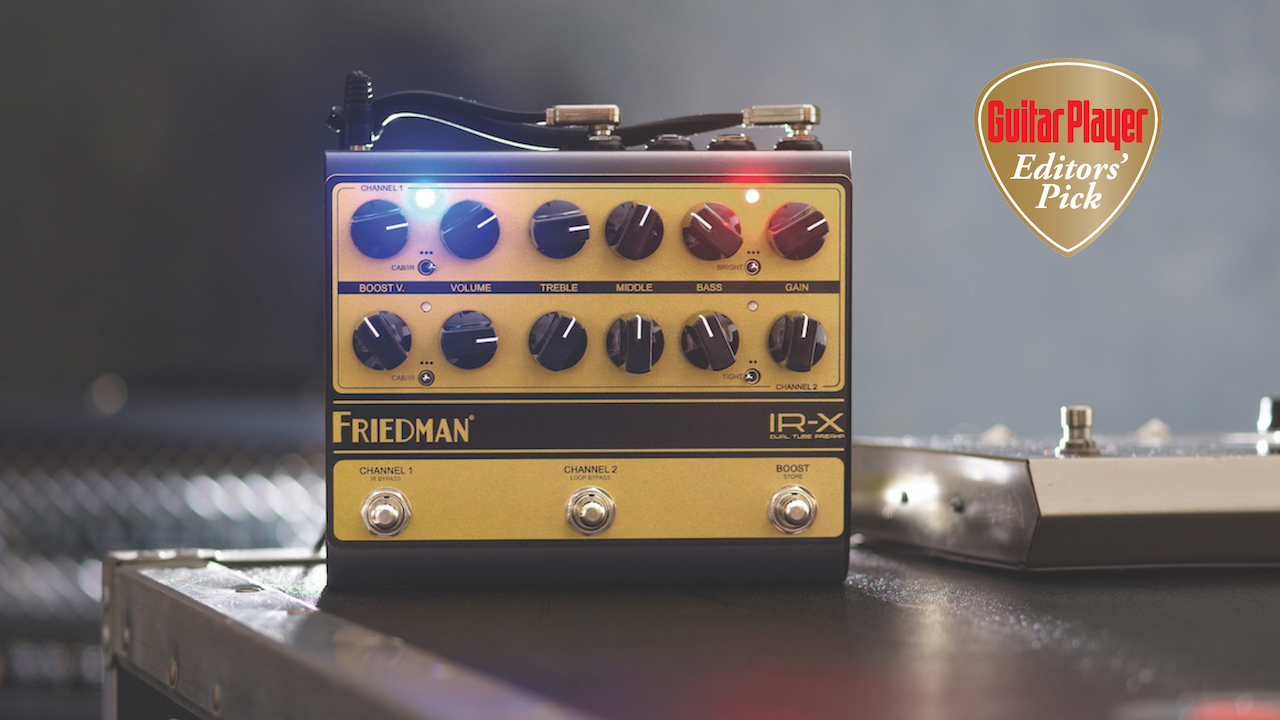GuitarPlayer Verdict
A boatload of tone and functionality earns the IR-X an Editor's Pick Award
Pros
- +
A great-sounding dual-channel tube preamp benefiting from IR speaker-cab functions and flexible connectivity
Cons
- -
Stereo out from IRs and delay effects in the loop would be handy, but likely more expensive
You can trust Guitar Player.
Few tube-amp makers have embraced the “if you can’t beat ’em, join ’em” ethos like Friedman, which notably allows use of its brand name in Fractal’s amp models, among others. Founder Dave Friedman and his team have already proven their ability to design and market traditional all-tube guitar amps that address guitarists’ needs for classic sounds wrapped in contemporary performance capabilities, and now the IR-X preamp and IR pedal finds the maker elbowing sideways into the digital amplification realm, while still working to its established strengths.
The IR-X is a dual-tube, two-channel, amp-voiced preamp that loads three speaker-cabinet impulse responses (IRs) per channel to enable a fully miked-up stack sound that can be DI’d to the front-of-house or your recording setup. Two 12AX7 tubes running at high voltage deliver all the gained-up goodness you’d expect from the front-end of a traditional multi-channel tube amp, while the back-end tech eliminates the heavy lifting of a power amp and speaker cab. There’s an effects loop for insertion of delay and modulation pedals, a MIDI input for more complex switching arrangements, a USB connection to access the Synergy-powered IR-X Editor on Windows or Mac computers, and an 1/8-inch headphone out for solo jamming.
Each channel includes controls for gain, bass, middle, treble, volume and boost. The foot switch for the latter also doubles as the store button with a long press, while the channel 1 and channel 2 foot switches double up on IR bypass and loop bypass, respectively. Channel 1, your clean channel, has Friedman’s traditional three-way bright switch, while channel 2 has a two-way Tight switch that focuses the low-end content for loose/vintage or modern.
Each channel also has a three-way toggle to select between the three onboard IR slots pre-loaded with top Friedman cab choices. Others cabs are available, and you can load your own IRs too. The right wall of the pedal carries an individual boost gain adjustment for each channel, which adds extra dirt to the boost function as you turn it up. It’s all packed into a rugged metal box that measures 6.5 by 5.5 by 2.3 inches, weighs 1.5 pounds and runs off an included 12VDC/600mA power supply.

As much as it’s plug-and-play, the IR-X also boasts extremely flexible rig integration. Options for use include employing it as a stand-alone with or without effects in front and in the loop; bypassing the IRs via the FX loop send and using it as a more traditional preamp into another guitar amp (while still sending the IR to front-of-house for a mic-free performance); or plugging another pedal’s or preamp’s output into the IR-X’s loop return to use it as a stand-alone IR loader.
By using MIDI switching into the IR-X, you can use presets created in the IR-X Editor to automatically change IR selection, channel, boost status, loop engage/bypass and two added parameters — presence and thump — for myriad tonal transformations. The rotary channel knobs, however, are analog and related to the tube preamp functions, and thus can’t be automated to MIDI presets.
I tested the IR-X with headphones; into a Universal Audio Apollo Twin Duo recording interface to my studio monitors; into a Fender FR-10 powered cabinet for more traditional “in the room” playing; and into the front-end of a Tone King Royalist MkIII 1x12 combo, bypassing the IRs. My guitars for this included a Gibson Les Paul and a Fender Telecaster. The tonal assessments that follow apply generally to all of these formats, which are essentially just different routes to a common sonic destination.
Having played through Friedman's amps, I'd say the IR-X captures their very useable foundations
First and foremost, I was eager to hear how the two channels sounded as core tone platforms; however clever the rest of the features may be, they’re of little use if the IR-X’s rhythm and lead tones don’t impress. Fortunately, they do. The Friedman templates for “clean with character” and “British overdrive” are well established by now, and having played through plenty of Friedman’s full amps over the years, I’d say the renditions on the IR-X ably capture their very usable and adaptable foundations.
Channel 1 offers plenty of clarity and shimmer, along with good depth and character, but it can also be driven into light-crunch territory by winding up the gain control and adjusting the channel’s volume to suit. This is where the clean channels on a lot of multi-channel amps fall flat. Even so, it remains a great platform for drive pedals placed in front of the preamp’s input.
A Wampler Tumnus Deluxe, an Ibanez TS10 Tube Screamer and — appropriately — a Friedman Small Box overdrive all interacted beautifully with the unit and, it should be noted, on both channels. While many all-digital amp modelers claim to play well with OD pedals, a tube-driven design like the IR-X has a leg up here since it’s presenting the same type of circuit interaction that takes place between a drive pedal and a traditional amp with similar preamp stages.

For many players, though, the lead channel is where it’s really happening in any Friedman amp. Channel 2 of the IR-X dishes it out in a way that will be broadly familiar to any fan of the maker’s signature, saturated hot-rodded “Plexi’” overdrive tones. Injecting the Les Paul and turning up channel 2’s gain to anywhere past noon delivers instant classic-rock goodness, with a thick yet articulate voice that sits beautifully in the mix. Winding it up toward max segues easily toward retro-metal, though it never gets overly flabby or out of hand. The Tight switch works well to tailor the low-end content, and the EQ performs as you’d expect it to on any good, traditional guitar amp.
But this channel’s gain settings below noon shouldn’t be ignored either, and there’s a useful range of early to mid-drive sounds that replicate a pushed non-master-volume tube amp or lower-gain channel switcher, making for good variety from channel 2 as well. Boost also functions just as it should on either channel. It can be a little over the top if cranked too high, but it’s a cinch to dial in.

Purists might claim these are not genuine Marshall tones, and that might be true both literally and figuratively. But as Dave Friedman has done with his amps for many years, the tones from the IR-X deliver something that might be closer to our common conception of classic Plexi tone as gleaned from both studio recordings and arena stage shows of the past five decades, and as such they are entirely successful in their endeavor.
Add in the useful effects loop and myriad connectivity — plus the programming and editing functions — and you’ll find there’s a lot of utility in this little sandwich-sized box. A stereo IR output would be nice, as would some facility for transmitting stereo delays in this way. Some players might also like to have more than three onboard IRs per channel. But designing such products requires a ratio of features-to-price, and some compromise therein, and I feel the folks at Friedman have pitched this one very well, on the whole.
For its boatload of tone and functionality, the Friedman IR-X earns an Editors’ Pick Award and will no doubt garner many fans. The only question that remains is whether it will lure guitarists even further into all-digital rig options, or stanch the flow and keep more players lighting up those tubes for the foreseeable future.
Specifications: IR-X Dual Tube Preamp and IR Pedal
Channels 2
Controls Gain, bass, middle, treble, volume, boost (all for each channel). Ch1: 3-way bright switch, 3-way IR switch; ch2: two-way Tight switch, 3-way IR switch. Foot-switches for ch1, ch2, boost, with additional side trimmers for boost gain.
Connections Guitar input, FX send and return, balanced output with ground-lift switch, MIDI In, headphone out, USB port, center-negative power in
Power 9 to 12 volts DC at 600mA, power supply included
Built USA
Kudos A great-sounding dual-channel tube preamp benefiting from IR speaker-cab functions and flexible connectivity
Concerns Stereo out from IRs and delay effects in the loop would be handy, but likely more expensive
Dave Hunter is a writer and consulting editor for Guitar Player magazine. His prolific output as author includes Fender 75 Years, The Guitar Amp Handbook, The British Amp Invasion, Ultimate Star Guitars, Guitar Effects Pedals, The Guitar Pickup Handbook, The Fender Telecaster and several other titles. Hunter is a former editor of The Guitar Magazine (UK), and a contributor to Vintage Guitar, Premier Guitar, The Connoisseur and other publications. A contributing essayist to the United States Library of Congress National Recording Preservation Board’s Permanent Archive, he lives in Kittery, ME, with his wife and their two children and fronts the bands A Different Engine and The Stereo Field.
"The only thing missing is the noise from the tape loop." We review the Strymon EC-1 Single Head dTape Echo, a convincing take on a very special vintage tube Echoplex
"BigSky MX will be replacing the BigSky as my go-to reverb pedal. I’ve heard nothing that covers all the bases with such pristine and detailed audio quality." We crowned the Strymon BigSky MX the champ of multi-reverb pedals












